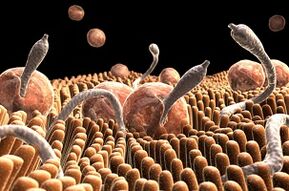
Helminth infection is possible even in our civilized society. These parasites imperceptibly penetrate the body and poison it with the products of their vital activity. Helminth secretions are toxic and cause a variety of ailments, from hives to serious health problems. There are also deaths.
Common Symptoms of Worm Infestation
Helminths not only live in human intestines, some types of parasites also infect other organs, they can even be in skeletal muscles. Therefore, the course of each helminthiasis has its own characteristic signs, but there are still general symptoms:
- reduced performance;
- rapid fatigue;
- intoxication;
- weakness;
- drowsiness;
- lack of appetite;
- weight loss;
- joint pain;
- constipation;
- intestinal disorder;
- intolerance to any type of food.
Unfortunately, many people are infected with parasites, some do not even know it. The eggs or cysts can be swallowed with apparently clean food. Often, the worms settle on the child's body, getting along with poorly washed fruits and vegetables, through dirty hands, from cats and dogs. The problem is that many times there is no suspicion that someone else lives in us, since there are types of parasites that do not appear for a long time. Therefore, it is worth knowing better about worms, what types there are and what symptoms of infection they cause.
Human intestinal worms
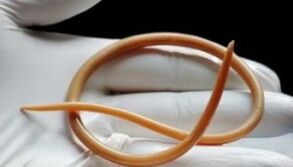
Roundworms, roundworms, whipworms, and Trichinella (less commonly) can live in the human body.
Roundworms are round worms with a spindle-shaped body, 15 to 40 cm long and 4 to 6 mm wide. This helminth lives in the small intestine, although there are cases when roundworms crawl into the bile ducts and obstruct them. Inside humans, females mate with males and lay eggs that, along with feces, come out.
A person is not infected with roundworms that live in animals.
The eggs should then mature on the ground. If they enter the human body with unwashed fruits or vegetables, the larvae are excreted in the intestines, quickly penetrate the blood vessels, and reach the lungs with blood flow. There, the larvae mature and migrate to the intestines through the trachea and oral cavity. And there, new individuals are born and everything repeats itself. Roundworms live up to 14 months.
With ascariasis, the appetite decreases, there is nausea, diarrhea, pain in the intestines, allergic manifestations. Sleep is also disturbed, irritability appears. When migrating from the lungs, there may be a cough. With the accumulation of roundworms and the formation of a ball by them, an intestinal obstruction can develop.
Pinworms are small whitish worms 3-12 mm long. Pinworms live in the small and large intestine. It is very easy to get these helminths, just do not wash your hands, or you can even swallow the helminth eggs by inhaling the dust. Female pinworms lay eggs in the anus, causing intense itching. Pinworm eggs are so small that they can even be inside with the dust that gets up.
You can get infected through bedding, hygiene items, food, handshakes, etc. Also, pinworms undergo the same migration as roundworms. Adults live in humans quite a bit, just 1-2 months, and with proper hygiene, they can be eliminated in a short time. In addition to itching, there are observed: insomnia, distraction, irritability, allergic rash.
Vlasoglavs are slender worms that live in the large intestine and reach a length of 30 to 35 mm. You can become infected with parasites in the same way as with roundworms. The vlasoglavs adhere to the intestinal walls and suck blood. The toxins they release cause headaches, lack of sleep, dizziness, and nausea. The life span of helminths is 5 years.
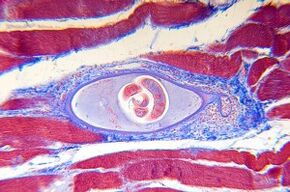
Trichinella are small worms, only up to 4 mm long. A person becomes infected through raw pork, which contains larvae. Adults live in the intestines, mate, and lay eggs, after which they die. Trichinella larvae are excreted, penetrate from the intestines into muscle tissue, where they form a capsule and can remain for years.
Helminthiasis causes the following disorders in the body:
- puffy face;
- edema of the eyelid;
- swelling of the legs and hands;
- skin rash;
- muscle pain;
- fever, temperature;
- headache;
- insomnia or, conversely, drowsiness;
- decreased mobility of the knee and elbow joints;
- Gastrointestinal disorders are observed.
Trichinosis is partially cured, since if the adult worms can be destroyed with drugs, the larvae of the skeletal muscles cannot be killed.
Tapeworms in humans
- The bovine tapewormcan be up to 10 m long. The infection occurs by eating undercooked beef, which contains helminth larvae. Housewives can get infected by trying raw minced meat with salt. In the body, a tapeworm develops from the larva, which lives in the intestines, and attaches itself to the wall for support. A person loses weight, loses appetite, dizziness, insomnia, nausea, and often vomiting appear.
- The pork tapewormis smaller, reaching only 2 m. The infection occurs after eating poorly processed pork. The symptoms are the same as with the bovine tapeworm.
- Broad tapewormhas a length of 6 m to 15 m The source of infection is raw freshwater fish. Helminthiasis manifests itself by weakness, nausea, vomiting, drooling, abdominal pain, constipation, or diarrhea. On the tongue there are always bright red sore spots and even cracks.
- Dwarf tapewormhas a length of 3-5 cm. They become infected with this helminth through contaminated door handles, toilet seats, if they have worm eggs. Children get sick more often. Helminthiasis causes decreased appetite, nausea and abdominal pain, and sometimes diarrhea. In rare cases, children can have seizures similar to epileptic seizures.
- Echinococcusis one of the most dangerous helminths. The infection occurs in dogs and cats, carriers of adult individuals of the parasite. In the human body, the larvae hatch from eggs, which are transported with the bloodstream to different organs, most often to the liver, where they form echinococcal cysts. In some cases, they even reach the size of the head of a newborn baby. Cysts are removed only by surgery.
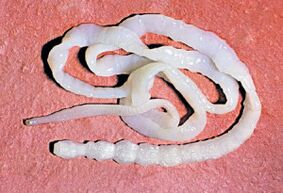
Human suckers
- Flukeparasitizes in the bile ducts and in the gallbladder itself. The size of the helminths is small - 4-13 mm. The parasite enters the body through the use of poorly salted or undercooked (fried) fish. First, this helminthiasis manifests itself with a high temperature (up to 40 degrees), pain in the joints and muscles, disorders in the gastrointestinal tract, in rare cases, jaundice develops. Then the acute symptoms disappear, there are paroxysmal pains in the pancreas. There may be complications.
- Fasciolais dangerous for health. The worms are up to 3-7 cm long and also settle in the gallbladder and biliary tract. A person becomes infected through unboiled water or by eating aquatic plants. Weakness, fever, headache and abdomen, hives appear.
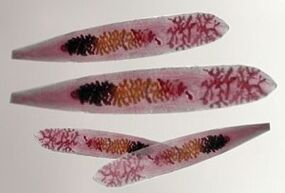
In conclusion about human helminths
Some types of worms live for years in the human body, as they can hardly manifest themselves in any way. Helminthiasis symptoms are often similar to diseases of the gastrointestinal tract, so a misdiagnosis is made if special tests are not performed to identify helminths. But you urgently need to get rid of any parasites, since they not only take useful substances from the body, but also release toxins that are dangerous to health.


























